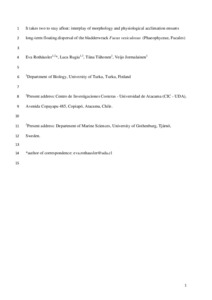It takes two to stay afloat: interplay of morphology and physiological acclimation ensures long-term floating dispersal of the bladderwrack Fucus vesiculosus (Phaeophyceae, Fucales)
Rothäusler Eva; Rugiu Luca; Tiihonen Tiina; Jormalainen Veijo
https://urn.fi/URN:NBN:fi-fe2021042825945
Tiivistelmä
Floating algae can be found in high abundances at mid and high latitudes, their prolonged positive buoyancy allowing long-distance dispersal. However, despite their importance to dispersal and ecological and evolutionary meta-population dynamics, little is known about the buoyancy responses of high latitude algae to the conditions at the sea surface. Indeed, even at 60 degrees N environmental conditions during spring/summer can be challenging, and may cause the demise and sinking of floating algae. The bladderwrack Fucus vesiculosus from the Northern Baltic Sea floats on the sea surface when detached from the benthic substratum. We conducted a field experiment with tethered individuals during their reproductive period to measure variation in floating time and how that is related to morphological traits such as occurrence of vesicles and/or receptacles, and to measure growth and photosynthesis while afloat. Algal individuals with receptacles tended to sink quickly, whereas the longest floating time was evident for individuals carrying vesicles but lacking receptacles. While afloat, all individuals grew in size, showed photosynthetic acclimation to sea surface conditions and had a few invertebrates associated with them. Our results showed that rafts of F. vesiculosus were physiologically viable until their day of sinking and that morphological traits such as the occurrence of vesicles and receptacles modified their floating time. Accordingly, floating algae with a similar morphological set-up, and thus also reproductive phenology, to F. vesiculosus can have a high floating persistence, but, depending on their reproductive structures, they may mostly serve as long-range dispersal vehicles for associated organisms.
Kokoelmat
- Rinnakkaistallenteet [27094]
